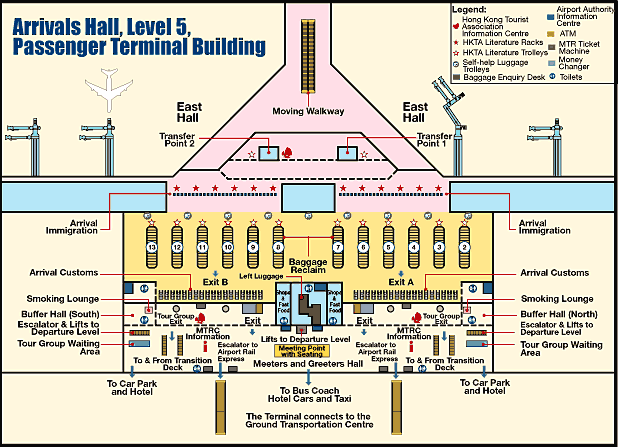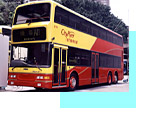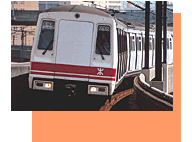
"At the stroke of midnight on June 30th, 1997, Hong Kong returned to China after 150 years of colonial rule, an exciting historical event. Hong Kong is a Special Administrative Region of China with a high degree of autonomy, operating under the arrangement of "One Country, Two Systems". It retains its own legal, social and economic systems which means no change in lifestyle for residents and visitors alike. Two years after the handover, Hong Kong is as vibrant as ever, bursting with life and dynamism. The calendar is overflowing with shows, events and festivals. Whole new areas of restaurants are spilling onto the streets and people are out in force lapping up an almost hypnotic carnival atmosphere. Never has Hong Kong been so entertaining. If you haven't been here in the past year, you haven't been to Hong Kong. "
-- from Hong Kong Tourist Association
Hong Kong Tourist Association contains a lot of useful infromation for visitors. Some major concerns are summaried below.
[Travel Tips] [Airport] [Visa] [Hotels] [Tour] [Transportation] [Climates] [Today's Weather]
Travel Tips
Q: When is
the best time to see Hong Kong?
A:
Hong Kong is an all-year-round destination, although the most popular
time to visit is from the middle of September to the end of February,
when the weather is cooler. At its coolest (mid-December to February),
the temperature averages 59?F; at its warmest (late May to mid-September),
it averages 82?F but may reach 91?F.
Q: Do I need a visa to visit Hong Kong?
A:
Visitors from most countries can enter Hong Kong without a visa for periods
of 7 days to 6 months, depending on nationality. Refer to our VISA
section for details.
Q: What vaccinations should I have?
A:
Normally, no vaccinations are required by the Hong Kong authorities. However,
visitors should check with their travel agent when making reservations,
as health regulations may change without notice.
Q: Where is the best area to stay?
A:
Hong Kong is compact, so visitors are never too far from shopping and
major sights. Also, Hong Kong has an excellent transportation system so
visitors can easily reach other areas, no matter where they stay. Most
hotels are located in the heart of the city, such as in Central, Wan Chai
and Causeway Bay on Hong Kong Island and in Tsim Sha Tsui and Tsim
Sha Tsui East in Kowloon. There is also a growing number of resort-style
hotels in the New Territories which offer relaxing alternatives.
Q: How long is the flight to Hong Kong?
A:
Please refer to the flight time below.
Q: How much is the airport tax on departure from Hong Kong?
A:
Along with most Asian destinations, Hong Kong charges an airport tax.
Here, it is HK$50 (about US$6.40) for travellers aged 12 years and older.
Q: Is local
transportation reasonably priced?
A:
Yes, very much so. Please refer to the chart below for current prices.
Q: Will I be expected to pay tips?
A:
Most restaurants will levy a 10 per cent service charge, but will expect
to be given some loose change. Restaurants that don't add a service charge
will expect a 10 per cent tip. However, the tipping is left to your discretion.
Bellboys, porters, restroom attendants and taxi drivers will happily accept
loose change.
Q: Will I be able to use my electrical equipment in Hong Kong?
A:
Voltage in Hong Kong is 220 volts, so a transformer will be needed to
operate 100-volt appliances. Most major hotels provide hair dryers and
other amenities.
Q: What can one expect to eat and drink in Hong Kong?
A:
To enjoy Chinese dining at its best, visitors may want to become acquainted
with provincial Chinese cuisines by reading up on them before arriving
in Hong Kong. Some of the dishes will be familiar and some won't. When
in doubt about what to order, ask the waiter for recommendations. In addition
to Chinese restaurants, there is a great variety of Asian and
Western dining available. Both Asian and Western beverages are widely
served; tap water is purified.
Q: Is Hong Kong safe for the visitor?
A:
Yes, Hong Kong is one of the safest cities in the world even at night,
when people may walk alone with confidence.
Q: Is English
widely spoken?
A:
Very widely spoken. There will be no problems in communicating with people
in most hotels, restaurants and even some taxis.
Airport
Airport
Terminal Map
Visitor Information
HKTA information services
Three HKTA Visitor Information Centres, open daily from 6am to 12am, are
located in the Transfer Area and Buffer Halls A & B on the arrival level.
The HKTA's maps and other tourist information are also on display at the
baggage reclaim area on the same level. Upon arrival in Hong Kong International
Airport's Custom Hall, visit our Visitor Information Counter for a welcome
pack that contains all the vital information that will make your stay
a smooth and wonderful experience.
Passenger information kiosks
These interactive information units operate with touch-screen
technology and provide information on a range of airport activities of
relevance to passengers. The information covers airport services and facilities,
flight schedules and world weather, terminal location aids and HKTA visitor
information.
Porter service
The Porter Service is free and available to all passengers in need
of assistance, such as the elderly, sick and physically handicapped.
There are two Porter Service Desks, located between Baggage Claim Belts
No.5&6 and Belts No.9&10. Visitors need to approach the desk to request
service between 0600 and 2300 daily.
Prearranged services for groups with special needs can be made to the
AA through the HKTA.
For VIPs, it is suggested that special baggage handling services be made
through the passenger's own airline.
Other useful information
Free phones for local calls are available in the Arrivals Hall
and in the baggage reclaim area. Local calls are free, except when using
the public coin phones, card phones and in hotels. Some immigration counters
are reserved especially for Hong Kong residents and are clearly marked.
24-hour hotlines offering (flight and general) information are available
in English : (852) 2181-0000 and Chinese : (852)
2181-8888
Transport
There are about ten transport services at the airport, the floowing
lists out the common methos. For the other, please click on this.
Airport
Railway
The Airport Core Programme's transportation infrastructure
is built to accommodate safe and efficient travel to and from the airport
site. The Airport Railway is comprised of the high-speed Airport Express
(AEL) and a Domestic Service (Tung Chung Line).
The 448-seater Airport Express takes approximately 23 minutes between
the airport and Hong Kong Station in Central, with 2 stops(Tsing Yi Station
and Kowloon Station) en route, operating at speeds of up to 135 km an
hour. Complimentary in-town check-in services for airline passengers at
Hong Kong Island and Kowloon stations are also provided. The fare is HK$70
for a one-way adult ticket from airport to HK Station. Travel time to
Kowloon Station is around 19 minutes with an adult fare of HK$60 one-way.
In fact since the 1st January 1999 passengers returning on the Airport
Express the same day will enjoy a free ride on their return journey. For
further details see our fare table below. This comfortable train with
its seat back TVs and excellent services at the stations like car parks,
Foreign Exchange centres, Flight schedule indicators, Trolley and Porter
service offer for fast and easy
transfer.
The Airport Express passengers have the added privilege of being able
to use the Free In-town Check-in Service. With this service they can check
in their bags and collect their boarding passes for same day flights anytime
upto 2 hours before take-off from the available airline counters at Hong
Kong and Kowloon stations. Though most airlines have a counter a few of
the smaller ones don't and thus you are advised to check with your airline
before departing Hong Kong.
What's more the Airport Express in well connected with the MTR network
and passengers can easily transfer to and from the AEL stations. Passengers
using an Octopus card can receive a complimentary MTR journey when using
it as a feeder service to the AEL and must travel on both within one hour.
Trains operate from 6am to 1 am daily, at 10-minute intervals.
Bus Services
There are 31 franchised bus routes serving the airport, operated
by Citybus Ltd and Long Win Bus Co Ltd. 23 are conventional lines primarily
of use to local residents and include both external and overnight bus
routes, while 8 are airbuses, dedicated to departing and arriving airline
passengers. They have fewer stops, stop at all major hotels, are air-conditioned
and provide luggage space to passengers. Tickets can be purchased at the
Customer Service counter in the
Arrivals Hall, or exact change can be dropped into the fare-collection
coin box on board.

(i.e. A11, A12, A21, A22, A31, A35, A41, A43)
Additionally, public buses may be taken from among 17 pick-up bays and
16 staging areas.
For all major bus routes and detail, please see this webpage.
Visa
You need a VISA? Please check here.
Visitors
from most countries can enter Hong Kong without a visa for periods varying
from seven days to six months, depending on their nationalities. Anyone
wishing to stay longer than the visa-free
period must
apply for a visa before travelling to Hong Kong.
For country-specific
visa information Applications should be made to the Immigration
Department, 2/F, Immigration Tower, 7 Gloucester Road, Wan Chai, Hong
Kong (Tel: (852) 2824 6111, Fax: (852) 2877 7711) or the nearest Chinese
Consulate. When applying for a visa, it is advisable to give at least
six weeks' notice. On arrival in Hong Kong, visitors will have to satisfy
immigration officers that they possess an onward or return ticket (unless
they are in transit to mainland China or Macau) and that they have adequate
funds for their stay in Hong Kong without work. (Generally, a confirmed
hotel reservation, a valid international credit card and/or an appropriate
amount of cash will suffice.)
Visitors are not allowed to enter employment (paid or unpaid), to establish
or join any business, or to enter school as a student. Nor, except in
the most unusual circumstances, are visitors allowed to change their status
after arrival.
Hotels
There are
alots of hotels in HongKong, but some of them may be too far apart from
the conference venue.The following are some suggestions. For other choice,
please visit this.
Suggestions
1. The Univeristy of Hong Kong, Robert Black College
Location
Robert Black College is situated in a
scenic spot of the University Campus in mid-level on the western side
of Hong Kong island. There are many routes of buses and mini-buses that
go from the College to the Central and other districts of Hong Kong. A
taxi ride from the city centre takes no more than ten minutes.
Accommodation
There are single rooms, twin rooms, suites and apartments in
the College. All rooms have attached bathrooms and are equipped with air-conditionors,
televisions, internet network, radios, telephones, refrigerators, etc.
Many rooms have either sea or mountain views.
Catering
There
are Chinese and Western cuisines. Breakfasts are provided. Lunches and
Dinners are available and there are pantries for guests to do their own
cooking.
Facilities
A self-service laundry, a drying room and an ironing room are
available. There is an automatic vending machine for drinks and snacks
and an IDD/coin telephone for making overseas calls. There are conference
and function rooms, lounges, a library, a billiard room and a gymnasium.
Facsimile machines, computers, type-writers and duplicating machines are
available for use by residents. Audio-visual equipment are also available
for lectures and seminars.
Tours
Transportation
Hong
Kong is geographically compact, with plentiful taxis and excellent public
transportation, so travel is generally quick and easy. Like most major
cities, though, it's best to avoid rush hours (8am-10am and 5pm-7pm) if
possible.
For long-staying visitors, an "Octopus" stored-value card will be useful.
It allows you to travel on the MTR, KCR, Light Rail, some outlying ferry
services, cross-harbour and city buses, and the Airport Express. Call
(852) 2993-8880 for enquiries.
Trains

There
are three rail systems. The Mass Transit Railway (MTR) is a dream: slick,
fast, clean and efficient. It runs along Hong Kong Island's northern coastline,
and travels beneath the harbour where branches serve Kowloon and Lantau
Island. An interchange at Kowloon Tong allows connection to the Kowloon-Canton
Railway (KCR). You'll know you're near an MTR station when you see this
symbol . Trains run from 6am-1am, max. fare for adult single journey HK$26.
For MTR enquires,
call (852)2881-8888. The Kowloon-Canton Railway (KCR) East Rail is a commuter
railway that runs from Hung Hom in Kowloon to the mainland China boundary.
Most trains terminate at Lo Wu except special express trains to Guangzhou.
You'll need a special ticket to travel to Lo Wu Station and into Shenzhen.
KCR trains run from 5:30am to 1am, max. fare HK$9, KCR enquires : (852)2602-7799.
The Light Rail (LR) connects the New Territories towns of Tuen Mun and
Yuen Long. The LR runs from 5:40am - 12:30am daily, with fares ranging
from HK$4 to HK$5.80. For enquires call (852)2468-7788.
Longer-staying visitors or those who ride the MTR, KCR and LR frequently
will find the Octopus card, a hi-tech debit card, very useful. Routes
of MTR, KCR and LR services are shown on the Transport Map.
Transport Map Climate
Hong
Kong consists of Hong Kong Island, the Kowloon peninsula, the New Territories,
and more than 260 outlying islands, totalling 1100 square kilometres.
To be exact, Hong Kong's locationis 22oN, 114oE. It is located just south
of the Tropic of Cancer at approximately the same latitude as the Bahamas,
Hawaii, and Mexico City.
While Hong Kong's sub-tropical climate does not offer the extremes endured
by regions to the north and south, there is a definite seasonal variation
that should be taken into account.
Spring: March to mid-May
Temperature: 18oC (64oF) to 27oC (80oF)
Humidity: Around 82%
Prevailing conditions: Occasional mist and rain showers.
What to wear: Have sweaters and showerproof jackets ready.
Summer: Late May to mid-September
Temperature: 26oC (79oF) to 33oC (91oF)
Humidity: 80% plus
Prevailing conditions: Normally sunny, but during the typhoon season
(July-September) there can be heavy rain.
What to wear: Short sleeves for outdoor wear on sunny days. Light
weight sweater for indoors as restaurants tend to
turn up the air-conditioning.
Autumn: Late September to early December
Temperature: 18oC (64oF) to 28oC (82oF)
Humidity: Around 72%
Prevailing conditions: Sunny and clear, ideal walking weather
What to wear: Light clothing for the day, and sweaters and light
jackets for the evenings.
Winter: Mid December to February
Temperature: 14oC (57oF) to 20oC (68oF)
Humidity: Around 72%
Prevailing conditions: Sunny, bright and coolish.
What to wear: Have woollens and overcoats ready.
Today's Weather